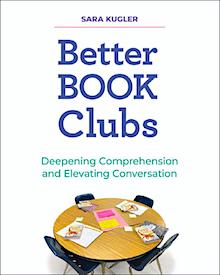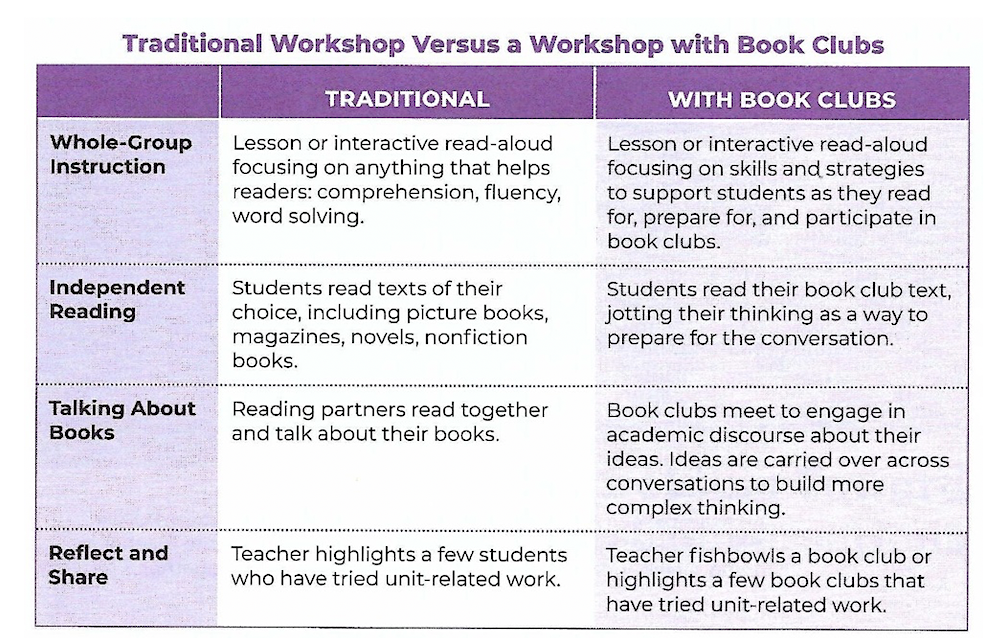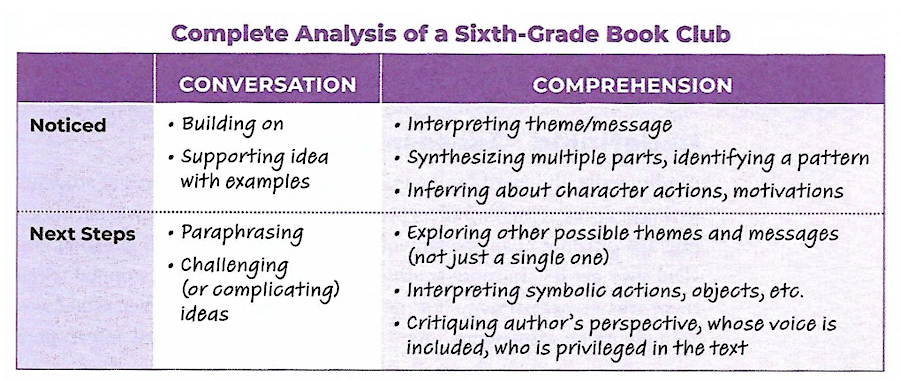Revamp Book Clubs to Deepen Comprehension
Better Book Clubs: Deepening Comprehension and Elevating Conversation
By Sara Kugler
(Stenhouse Publishers 2022 – Learn more)
Reviewed by Anne Anderson

If you are feeling lost in the post pandemic classroom, this book can serve as a compass to redirect and reenergize your efforts to engage students. Also, book clubs provide an opportunity to differentiate instruction.

In the book’s six chapters, the author inspires while sharing practical tools and strategies. Sara Kugler is all about the what and the how.
In Chapter 1: Grounding Book Clubs in the Predictability of Workshop, the author uses her personal experiences and provides a clear explanation of traditional workshops versus workshop with book clubs. This chart from page 15 summarizes those differences:

Scaffolding
Again drawing from her personal experiences, she shares what she has learned about scaffolding book clubs. Kugler suggests that teachers alter their thinking and consider book clubs as a long-term goal rather than a starting point. She proposes using interactive read-alouds as an opportunity to model and coach readers new to book club. As teachers plan the stopping points in these interactive read-alouds, four concepts should be considered: authenticity, multiple possibilities, tentative thinking, and intensity of scaffolding.
The scaffolding continues as students move into whole-class conversation. Be prepared – sustaining and developing whole-class conversations can prove challenging. Therefore, the author addresses three of those predictable challenges. With the teacher helping students learn authentic ways to participate in group discussions, they are also learning useful life skills.
Interactive read-alouds, whole-class conversations, and read-aloud book clubs are designed to move students toward independence. The good news is that the author guides teachers on this journey. She explains how she scaffolds these learning experiences. Kugler offers this piece of advice: “You might try not to make eye contact with the students.” Think about it – students are accustomed to looking at the teacher when responding.
Grouping and Scheduling
Kugler offers options related to grouping and scheduling the book clubs. Using her experiences in an adult book club, she aids students in forming a cohesive group. The groups may be based on student interest, by reading level, or by choice. She explores the benefits and challenges of each option.
Students are invited to create a club name, to establish some club norms, and even choose a “clubhouse” – that special spot in the classroom where they would meet. The elementary students created club names including Star Readers, Best Book Club, and my personal favorite, Recess Queens.
Collecting and Analyzing Data
As the author moves into Chapter 4: Utilizing Talk as an Assessment, she suggests that we approach data as “any information we can gain about what the readers in our class can do or are trying to do.” (p. 50) Here she explains how to collect data and how to analyze it. She suggests analyzing student talk in two ways: conversation skills and comprehension skills. This chapter includes transcripts from two different book clubs, Kugler’s analysis of the groups’ discussions, and her next steps. Her notes based on the sixth-grade book club (p.65) are shown here.

Comprehension and Conversation
In Chapter 5: Teaching for Comprehension and Conversation, Kugler explains how she uses her observations and transcripts to narrow the instructional focus.
After prioritizing each book clubs’ instructional needs, she moves into the teaching phase. She meets with each book club to introduce their next book with three goals: pique readers’ interest, serve as scaffolding, and set readers up for complex thinking. Again, she offers transcripts from two book clubs as a reminder that comprehension and conversation are interdependent, writing: “Each group, each day, each book will require varying degrees of support from you.” (p. 81)
The appendices are an integral part of Better Book Clubs since they provide support to get teachers started.
- Appendix A: Noticed/Next Steps Matrix
- Appendix B: Book Club Planning Document
- Appendix C: Touchstone Anchor Charts and Sample Lessons
Each appendix is clear, concise, and easy to use.
Creating better book clubs is so worth doing
For me, reading Better Book Clubs felt like a personal professional development seminar with Sara Kugler. She provides teachers with a valuable resource that supports authenticity and independence in book clubs. There will be challenges! But the payoff will be worth it. Her frequent references to what she has learned from Lucy Calkins, Irene Fountas, Gay Su Pinnell, Katy Wood Ray, Jennifer Serravallo, and others is reassuring. Sara Kugler sums it up on page 107:
“Once you have the tools, it’s up to you to innovate beyond what I suggest here. When it comes to responsive, student-centered teaching, there are no rules to be followed, only decisions to be made.”
Personal note: Stenhouse’s Jill Shaffer deserves an “A+” on the interior design! Using the color coded speech bubbles for group discussions makes this book visually appealing. The soft color pallete along with Sara Kugler’s straightforward writing style make this book a wise addition to any educator’s professional library.
Read Sara Kugler’s MiddleWeb article:
How We Use Book Clubs to Empower Our Readers
Anne Anderson always knew she wanted to be a teacher. She graduated from East Texas Baptist University with an English major and History minor and did graduate work at Louisiana State University and Louisiana Tech University. After teaching 8th graders for 24 years, Anne served as a content coach. Since retiring in 2011, Anne has worked as an educational consultant, presenting at national conferences and onsite trainings for public and private schools.
Calendar Celebrations: March, April, May is part of Anne Anderson’s trilogy on quick, engaging activities and resources for months of the school year. (For MiddleWeb she wrote about selected winter celebrations here, about fall here, and about spring here.) Anne has also published articles in IDEAS Plus and Voices from the Middle, publications of the National Council of Teachers of English. She is a frequent reviewer of professional books for MiddleWeb.com.






























